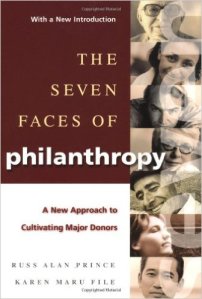 Earlier this week and last week, I started writing about the State of Illinois’ budget crisis and how it is impacting non-profit organizations. In Part 1 of this series, I shared survey results provided by United Way of Illinois along with other insights and perspectives . In Part 2, I talked to a non-profit executive director whose organization lost significant funding as a result of Illinois’ budget impasse and shared some surprising developments. Today, I have a suggestion for Illinois non-profit leaders to mull over as the crisis deepens (and there is lots here for non-profit leaders from other states to chew on, too).
Earlier this week and last week, I started writing about the State of Illinois’ budget crisis and how it is impacting non-profit organizations. In Part 1 of this series, I shared survey results provided by United Way of Illinois along with other insights and perspectives . In Part 2, I talked to a non-profit executive director whose organization lost significant funding as a result of Illinois’ budget impasse and shared some surprising developments. Today, I have a suggestion for Illinois non-profit leaders to mull over as the crisis deepens (and there is lots here for non-profit leaders from other states to chew on, too).
Frog in boiling water
We’ve all heard the story about frogs and boiling pots of water. Right?
Assuming that some of you haven’t any clue of what I’m talking about, here is a nice summary from Wikipedia:
“The boiling frog is an anecdote describing a frog slowly being boiled alive. The premise is that if a frog is placed in boiling water, it will jump out, but if it is placed in cold water that is slowly heated, it will not perceive the danger and will be cooked to death. The story is often used as a metaphor for the inability or unwillingness of people to react to or be aware of threats that occur gradually.”
I have no clue what the origins of this old story are, but I do know this . . .
IT IS A MYTH!
 Don’t want to take my word for it because you might have heard it from your grandfather or another beloved family member. No problem … I completely understand. Let me provide you with scientific proof. Simply click here, click here for more, and click here if you are in deep denial. If you clicked all three links, I’m guessing you probably also believe a number of other grossly inaccurate things about other animals and suggest you the Snopes.com article titled “Critter Country: Wild Inaccuracies”
Don’t want to take my word for it because you might have heard it from your grandfather or another beloved family member. No problem … I completely understand. Let me provide you with scientific proof. Simply click here, click here for more, and click here if you are in deep denial. If you clicked all three links, I’m guessing you probably also believe a number of other grossly inaccurate things about other animals and suggest you the Snopes.com article titled “Critter Country: Wild Inaccuracies”
So, what does any of this silliness have to do with non-profits and the Illinois budget impasse?
Your organization is like a frog!
In other words, your non-profit should (and likely will) jump out of the boiling waters of government funding if things get too hot. It is a simple matter of survival.
Question #1: When?
I’ve lamented too often — right here on this blog — that too many non-profit boards operate poorly. They don’t understand (and sometimes reject) their legally defined fiduciary responsibilities, focus their meetings obsessively on monitoring rather than governance, micromanage the organization and its staff, rubber stamp things (oftentimes very important things) that staff put in front of them, and my list can go on and on.
If anything in the last paragraph describes your organization’s board of directors, please hear me clearly . . .
You’re at risk!
In other words, you might just be on the road to proving all of the scientists, who said in the last section that “the boiling frog story is an urban legend,” are liars.
 Your board is likely made up of smart people. If they aren’t being used (at a minimum) as a “sounding board” on the issue of government funding and what to do about it, then my suggestions are:
Your board is likely made up of smart people. If they aren’t being used (at a minimum) as a “sounding board” on the issue of government funding and what to do about it, then my suggestions are:
- Stop business as usual in your boardroom
- Start adding a 45 minute “generative discussion” agenda item to every one of your monthly meetings for the foreseeable future
- Focus your discussions around various aspects of your government funding situation
- Bring in guest speakers who know more than you do about state funding and your grants
- Pose open ended questions and facilitate an engaging dialog where everyone is encouraged to share their thoughts and feelings
- Don’t just have theoretical conversations … also pose action oriented questions (e.g. what are our options? what should we be doing?)
If you and your board can make this adjustment in non-profit governance, I guarantee you that . . .
It will be clear when it is time to jump out of the boiling pot!
Question #2: What?
 Of course, the more difficult question for most non-profit organizations is “What to do about it?”
Of course, the more difficult question for most non-profit organizations is “What to do about it?”
If your organization isn’t reliant on government funding, the answer is easy . . . carry on and try not to gloat too much around your non-profit friends. For those of you who rely on modest (or perhaps significant) government money, then you want to keep reading.
If you and your board have decided the water is getting a little too hot, then here are a few suggestions:
- Re-exam your non-profit revenue model
- Explore other models (refer to previous section about generative discussions in the boardroom)
- Make a group decision about which model (or hybrid model) is best for your organization at this time
- Don’t try to turn the battleship all at once … choose one (or a few) things to “try on for size” and experiment with small aspects of your new revenue model (e.g. write a private sector foundation grant, engage a corporate partner, identify prospective individual donors and start a conversation with them; write a business plan for a potential social enterprise, etc)
- Invest time, energy and effort in evaluation of every new thing you undertake and commit to nurturing a culture of improvement and excellence
- Celebrate every success from top-to-bottom and side-to-side of your organization (no matter how big or small it may be)
If you got this far and still find yourself scratching your head over the idea of different non-profit revenue models, then you need to click-through and read a Bridgespan white paper titled “Ten Nonprofit Funding Models“. I also highly suggest clicking on and reading every hyperlink embedded in the white paper.
If you don’t believe your organization can do this without help, then I have some good news. There are countless non-profit consultants (myself included) who are available for hire.
Stop listening to stupid people
 I’ve heard state funders (e.g. foundations, United Ways, etc) say loudly and clearly, “The state cannot expect funders to fill the gap created by the State“.
I’ve heard state funders (e.g. foundations, United Ways, etc) say loudly and clearly, “The state cannot expect funders to fill the gap created by the State“.
I do NOT believe foundation leaders and United Way professionals are “stupid people“. However . . .
I have heard some people (in fact some are even dear friends of mine), amplify the cautionary words of foundations and United Ways and then twist them by concluding “private sector philanthropy” cannot fill the gap. It is these folks to whom I urge you to please stop listening.
The reality is that foundations, corporations and United Ways only account for 20% of the $358 billion of charitable giving. The remainder of the pie (a huge whopping 80%) comes from individuals either directly or through bequests.
Moreover, charitable giving is only 2% of our country’s GDP.
The pie can be increased. There is room to expand and grow. Foundation leaders and United Way professionals never said private sector philanthropy couldn’t be the solution (or at least a big part of the solution). They were simply say that politicians need to stop telling voters their organizations will fill the gap.
Are you a doubting Thomas? If so, then I have a proposition for you . . .
Add this topic to your board agenda. I think it makes for an awesome generative discussion. If you’re an Illinois non-profit organization and you’re looking for someone to speak in your boardroom on this subject and facilitate a generative discussion, then please contact me because I would be willing to consider it.
Next up in this blog series?
I’ve sent emails to a handful of politicians and policymakers who I trust and respect. I’ve invited them to share their thoughts on this subject. If any of them respond, then I’ll publish those next week.
In the meantime, please use the comment box to share your thoughts and experiences on the Illinois budget impasse, the impact you’re seeing on the non-profit sector, your thoughts on what organizations should be doing about it, or anything else that is top of mind regarding the state of government funding (federal, state or local) and those trends. We can all learn from each other.
Here’s to your health!
Erik Anderson
Founder & President, The Healthy Non-Profit LLC
www.thehealthynonprofit.com
erik@thehealthynonprofit.com
http://twitter.com/#!/eanderson847
http://www.facebook.com/eanderson847
http://www.linkedin.com/in/erikanderson847

 Here is what I didn’t expect to hear:
Here is what I didn’t expect to hear: Believe it or not, this phenomenon has a name. It is called the
Believe it or not, this phenomenon has a name. It is called the  One of my favorite movie scenes is at the
One of my favorite movie scenes is at the  You have lots of short-term options that will help bridge your organization through a cash flow crisis. The following is a short list of some of those options:
You have lots of short-term options that will help bridge your organization through a cash flow crisis. The following is a short list of some of those options: If I’ve seen it once, I’ve seen it a number of times . . . board volunteers want to hold someone accountable after the crisis passes. In my opinion, the best way to survive this dynamic is to be able to point to:
If I’ve seen it once, I’ve seen it a number of times . . . board volunteers want to hold someone accountable after the crisis passes. In my opinion, the best way to survive this dynamic is to be able to point to: Now that you’ve made it through the crisis and have a firm understanding of what caused it, it is important have a new long-term plan that keeps you from ending up back from where you just came.
Now that you’ve made it through the crisis and have a firm understanding of what caused it, it is important have a new long-term plan that keeps you from ending up back from where you just came. Your nonprofit is constantly trying to improve. Whether you’re developing an efficiency hack for your staff members or trying new fundraising events, openness to change is what allows your organization to grow, acquire more donors, and raise more money for your cause.
Your nonprofit is constantly trying to improve. Whether you’re developing an efficiency hack for your staff members or trying new fundraising events, openness to change is what allows your organization to grow, acquire more donors, and raise more money for your cause. Abby Jarvis is a blogger, marketer, and communications coordinator for
Abby Jarvis is a blogger, marketer, and communications coordinator for  Well, it happened to me and my husband again just the other day. We were asked to dinner by a non-profit friend. It was a simple dinner invitation, and one that we’ve been working on setting up for more than a year. We weren’t in the restaurant for more than 15 minutes and the pre-meal cocktails had just arrived, when our friend was asking us to give some consideration to making a contribution to their organization’s endowment fund.
Well, it happened to me and my husband again just the other day. We were asked to dinner by a non-profit friend. It was a simple dinner invitation, and one that we’ve been working on setting up for more than a year. We weren’t in the restaurant for more than 15 minutes and the pre-meal cocktails had just arrived, when our friend was asking us to give some consideration to making a contribution to their organization’s endowment fund. Simply, I believe soliciting unsuspecting prospects and donors is detrimental to your organization (and to everyone else in non-profit sector) for the following reasons:
Simply, I believe soliciting unsuspecting prospects and donors is detrimental to your organization (and to everyone else in non-profit sector) for the following reasons: In an effort to do may part to help eradicate the “ambush” tactic from our non-profit toolbox, I will share with you some of the tips from this video.
In an effort to do may part to help eradicate the “ambush” tactic from our non-profit toolbox, I will share with you some of the tips from this video. It was a bleary-eyed late night dash in a rental car to position myself for a morning meeting, and I was listening to National Public Radio (NPR) in an effort to stay awake. At one point, someone was interviewing iconic feminist leader Gloria Steinem. While I cannot remember the big reason for the interview (e.g. new book, rally, election analysis, court ruling, etc), there was one thing that stuck with me, and I just had to share with you because I think it is a great allegory for how your non-profit should interact with donors.
It was a bleary-eyed late night dash in a rental car to position myself for a morning meeting, and I was listening to National Public Radio (NPR) in an effort to stay awake. At one point, someone was interviewing iconic feminist leader Gloria Steinem. While I cannot remember the big reason for the interview (e.g. new book, rally, election analysis, court ruling, etc), there was one thing that stuck with me, and I just had to share with you because I think it is a great allegory for how your non-profit should interact with donors. For me, sometimes people speak the truth and it hits me in such a way that I have a hard time getting it out of my head. It rolls around like a pinball in my brain, and the only way for me to stop the experience is to write about it. Well, this happened again on January 28, 2016 at approximately 10:15 pm while I was watching a Special Edition of Hardball with Chris Matthews. It occurred during an interview with Mike Huckabee, when the former presidential candidate said something close to the following (and if memory serves me correctly, I think it was in response to a question about the primary election system):
For me, sometimes people speak the truth and it hits me in such a way that I have a hard time getting it out of my head. It rolls around like a pinball in my brain, and the only way for me to stop the experience is to write about it. Well, this happened again on January 28, 2016 at approximately 10:15 pm while I was watching a Special Edition of Hardball with Chris Matthews. It occurred during an interview with Mike Huckabee, when the former presidential candidate said something close to the following (and if memory serves me correctly, I think it was in response to a question about the primary election system):
![20160121_131831[1]](https://donordreams.files.wordpress.com/2016/01/20160121_1318311.jpg?w=300) Recently, I’ve been working with Boys & Girls Club of Watertown on a project, and a few months ago staff asked me if I wanted to schedule my January return trip around their
Recently, I’ve been working with Boys & Girls Club of Watertown on a project, and a few months ago staff asked me if I wanted to schedule my January return trip around their ![20160122_205458[1]](https://donordreams.files.wordpress.com/2016/01/20160122_2054581.jpg?w=169) In a nutshell, a camel race is a game of chance. It involves betting, dice rolling and moving decorated camels through a race course. Here are a few details:
In a nutshell, a camel race is a game of chance. It involves betting, dice rolling and moving decorated camels through a race course. Here are a few details:![20160122_205516[1]](https://donordreams.files.wordpress.com/2016/01/20160122_2055161.jpg?w=300) Two very large fuzzy dice are rolled and the numbers rolled move the camel with the corresponding number one space forward on the race course (e.g. if a two and six are rolled then camel #2 and camel #6 each move one space)
Two very large fuzzy dice are rolled and the numbers rolled move the camel with the corresponding number one space forward on the race course (e.g. if a two and six are rolled then camel #2 and camel #6 each move one space)![20160122_171636[1]](https://donordreams.files.wordpress.com/2016/01/20160122_1716361.jpg?w=169)
![20160122_171639[1]](https://donordreams.files.wordpress.com/2016/01/20160122_1716391.jpg?w=168)
![20160122_171644[1]](https://donordreams.files.wordpress.com/2016/01/20160122_17164411.jpg?w=169)
![20160122_171648[1]](https://donordreams.files.wordpress.com/2016/01/20160122_1716481.jpg?w=169)
![20160122_171652[1]](https://donordreams.files.wordpress.com/2016/01/20160122_1716521.jpg?w=169)
![20160122_171655[1]](https://donordreams.files.wordpress.com/2016/01/20160122_1716551.jpg?w=169)
![20160122_171700[1]](https://donordreams.files.wordpress.com/2016/01/20160122_1717001.jpg?w=168)
![20160122_171705[1]](https://donordreams.files.wordpress.com/2016/01/20160122_1717051.jpg?w=168)
![20160122_171707[1]](https://donordreams.files.wordpress.com/2016/01/20160122_1717071.jpg?w=169)
![20160122_171711[1]](https://donordreams.files.wordpress.com/2016/01/20160122_1717111.jpg?w=168)
![20160122_171717[1]](https://donordreams.files.wordpress.com/2016/01/20160122_1717171.jpg?w=169)
![20160122_171727[1]](https://donordreams.files.wordpress.com/2016/01/20160122_1717271.jpg?w=169)
![20160122_171732[1]](https://donordreams.files.wordpress.com/2016/01/20160122_1717321.jpg?w=168)
![20160122_171749[1]](https://donordreams.files.wordpress.com/2016/01/20160122_1717491.jpg?w=169)
![20160122_171814[1]](https://donordreams.files.wordpress.com/2016/01/20160122_1718141.jpg?w=168)
![20160122_205535[1]](https://donordreams.files.wordpress.com/2016/01/20160122_2055351.jpg?w=300) Special event fundraising is:
Special event fundraising is: